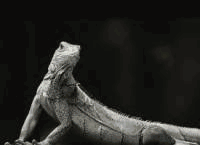| Go To : TWL Annex : PetHobbyist.com : kingsnake.com |

--
Charles Schulz |
|
||||||||||||||||||||||||||||||||||||||||||||||||||||||
The Iguana Information Resource Page
| Position Statement
| Misconceptions |
| Food Basics | Lighting Basics
| Heating Basics |
| Growth & Enclosure Basics | Iguana
Maturity | Health & Vets |
| Useful Reading References | Rescues
& Rescuing |
| Webmaster Contact Information |
yes, we have a disclaimer of sorts (go figure).
Several members of the kingsnake.com Iguana Forum conceptualized the Iguana Information Resource Page you see here. Many folks have had a hand in turning that idea into what you see before you.
There are many misconceptions surrounding the proper care and keeping of green iguanas. This page is designed to help start individuals on a path of finding their way through the maze of information that is out there for the taking. Not everyone will agree with the information and/or opinions contained within this document and no one is saying they should. This page is just one of many resources available to you. The responsibility for the research into the proper care and keeping of iguanas as well as the separation of fact from fiction regarding that information ultimately lies with the owner(s). Every iguana owner or potential owner has the ability to form their own opinions and come to their own conclusions on what they feel is best for their iguana.
Visitors to this page are free to accept the ideas, thoughts and opinions contained in this document for what they are worth as they are free to set them aside. We simply hope that you find something of value here no matter how large or small it may be.
Breaking Down the Misconceptions 
Misconception: Iguanas have no personality.
Reptiles, in fact, do have personalities. Just ask any iguana to find out. Some iguanas are dominant while others are submissive. Some iguanas can be very nasty and easily provoked, but with a certain degree of effort on the part of the owner, most can be socialized. Some iguanas become so mellow that they can be taken into large groups and not care about anything except the shoulder they are lying on. One thing to remember is that iguanas are still very much wild animals with wild instincts and their own individual personalities. Caution should always be exercised when placing any iguana into an unfamiliar setting or exposing it to new situations.
Misconception: Iguanas make GREAT pets for children and are low maintenance!
It takes a lot of hard work and preparation for an owner to maintain healthy living conditions in their home for a pet iguana. Daily cleaning of their enclosure, being fed twice a day and maintaining correct temperature and humidity levels is necessary. The iguana's rainforest-like natural habitat varies considerably to the environmental conditions (temperature and humidity) found in your home. Preparation of weekly diets can easily take an hour or more of your time each week due to the need for consistently fresh vegetables. To keep iguanas socialized, you must interact with them on a regular, if not daily, basis. Important fact: it is by far easier to get a dog sitter than an iguana sitter for vacations!
As with buying a car, parents must research the care and needs of any pet the family may get. When parents give in to their child's incessant requests for a pet iguana, they must first realize that this pet will be THEIR responsibility - not the child's. Parents are the primary caretakers and providers in the family. Children, even those with modest allowances, are unable to afford the bulk of the cost for necessary supplies, food, and veterinary costs associated with the keeping of these animals. Salmonella is a possible concern for iguana owners, especially when children are involved. It is important to always stress and practice proper hygiene. Parents must also realize that iguanas are wild animals and present a very real danger to children (and adults too!). An iguana's body is a formable weapon - sharp claws that scratch and rake the skin, a razor-edged tail that can be whipped around hard enough to cut skin, razor sharp teeth and powerful jaws for biting and possibly removing large chunks of flesh. The injuries caused by iguana bites can be severe enough to result in trips to the emergency room. Some people have lost parts of fingers, suffered nerve damage, and permenant scarring; some even had to have cosmetic surgery after an attack from an iguana, even very tame, highly socialized, iguanas.
Misconception: Iguanas Eat Meat.
Iguanas can live to be about 20 years of age, but many fed a steady diet of meat by-products are living an average of only 8 years. Why do they die? We now know that diets high in animal protein are a major contributor to these early deaths. The diet of the iguana is the most widely misunderstood aspect of their care. Although many books on iguana care as well as advice from people, including some veterinarians, still say that iguanas need animal protein to live, especially when they are young, we know this is not true. Research on the long-term effects of animal protein in the diets of iguanas has shown that feeding animal protein in significant quantities can cause various health problems, including kidney failure, and often leads to an early death.
Iguanas need a healthy, varied diet consisting of dark, leafy greens (collard, mustard, endive, escarole, turnip, etc.), which contribute 70-80% of the overall diet, fruit (5-10%) and the remainder a variety of other vegetables. Nutritionally speaking, you should strive to make sure that you have 2 times more calcium than phosphorus in the food that the iguana receives. Mineral supplements free of phosphorus may be use to help increase the calcium levels. Remember variety is the spice of life! When fed a proper diet, you cannot over feed an iguana.
Misconception: Iguanas do not need UV lights like some other reptiles.
Wild herbivores, such as iguanas, obtain the needed vitamin D3 they require through the UVB exposure they receive while basking under the sun. At this time it is not certain that they can utilize ingested supplemented D3 or the D2 they get from eating plants. While outdoor sunlight is the best light, not all iguana owners are in a position to provide their iguanas with regular or semi-regular exposure to sunlight, so providing artificial sources of UVB and UVA is necessary.
Keep in mind that not all lighting products are created equally. Most packaging for light bulbs marketed for reptiles claim to simulate natural sunlight, but they really do not. Incandescent light bulbs typically put out a lot of heat and produce some UVA, but no UVB.
To provide supplemental UVB, one needs to make use of fluorescent light tubes made specifically for reptiles. (The fluorescent tubes made for human use are shielded to prevent the emission of UVB; the tubes made for reptiles are made specifically to allow emission of UVB and UVA.). There are a variety of commercially available made-for-reptiles fluorescent light tubes that provide a range of UVB emissions. UV fluorescent bulbs are not cheap and must be replaced every 6-12 months. The visible light may still function but the UV levels degrade as time goes by, with too little being emitted at the end of the year to be of use by UVB-dependent reptiles. It is also important to keep in mind that UV emissions are filtered out to various degrees when passing through items such as glass and plastics, thereby lowering or negating the effectiveness of those UV lights. Iguana owners should strive to provide their animals with UV that is not filtered through or blocked by caging materials.
Fluorescent lights emitting 5-8% UVB are often recommended. UVB emissions are short-ranged - the further away from the light source, the lower the amount of UVB that actually reaches the iguana. UV fluorescent lights should be no farther than 12 inches from the basking point within the enclosure.
A new product on the market is Mercury Vapor Lights (a mercury-based device that produces both visible bright light and heat as well as high levels of UVA and UVB). This product, while still the basis of much controversy in the reptile community, is reported to be effective in producing sufficient amounts of UV rays with a greater range of distance from the light source. This option can be carefully considered and researched by iguana owners as incandescent lights also provide a source of heat.
Iguanas are cold-blooded animals, which means they cannot create enough body heat to keep their metabolism and other body functions running the way they need to in order to help keep the iguana healthy and functioning properly. In the wild, they bask in the sun, moving into the shaded areas when they are warm enough. In captivity, we need to provide iguanas with a heat source that provides a large area within the enclosure that reaches of 90 degrees Fahrenheit. They also need a cooler area (75-80 degrees F.). Providing an iguana with a selection of different temperatures in the enclosures enables them to regulate their body temperature and properly digest their food. The iguana must have the ability to go from a warm spot to a cooler spot and vice versa. Please remember, this is not a guessing game: you have to use thermometers in different areas of the enclosure to monitor the temperatures. At a minimum, at least one thermometer is placed where it is warmest (usually right around the basking spot) and one placed away from basking spot.
Iguanas require darkness at night, so it is important to remember that when you turn off those basking lights you are taking away a good portion of their heat source. You must provide iguanas with an alternative nighttime heat source if the temperature of the enclosure drops below 70 degrees Fahrenheit at night. You cannot use the daytime white or bright light producing heat lamps for nighttime heating. This is where items such as red or purple incandescent light bulbs (the fake type of "black lights") and Ceramic Heat Emitters (CHEs) come in handy. Many stores sell "hot rocks" or "sizzle stones" as appropriate heat sources for reptiles. These items in fact are to be avoided because iguanas (and other reptiles) are known to severely burn themselves from direct contact with these items. Such burns tend to occur because the item got too hot or the reptile did not have the sense to get off it (usually because the rock might be the only source of heat available to the reptile and the reptile was desperate to warm up). Sadly, many iguanas are scarred for life or in some cases die from such burns due to secondary infections or other complications.
Misconception: Iguanas will only grow as large as their tank allows.
Despite what some sources say, keeping an iguana in a smaller enclosure will not keep the iguana small. This idea came about from many years of poorly cared for iguanas that lived a year or less. Of course, at that age, it is a given that they will not grow larger than the cage. Iguanas will keep growing when given proper care. Part of the problem is that many pet store employees are not knowledgeable in the specific care of iguanas or read only out-dated and inaccurate literature and pass this along to unsuspecting customers. The employee may believe he/she is providing correct information, or may be deliberately misleading the customer. All too often, an unsuspecting shopper is convinced to purchase an animal they are not actually prepared to keep and care for.
Within their first year, iguanas will double their original size. By the age of two, iguanas can be 2 feet or larger and by 4-5 years the iguana may be in the area of 5 feet. Due to their large size, many owners devote an entire room to their iguana's habitat. Some owners also make use of large custom ordered bird aviaries for housing their iguanas in. Iguanas are known to occasionally become aggressive when housed in small enclosures. Put this all together and buying as large a cage as possible to start out with will be fiscally better for you the owner and make for a happier iguana. When starting out with a hatchling, it is suggested nothing smaller than the equivalent of a 55-gallon aquarium should be used for housing the iguana. Whenever possible it is best to choose an enclosure design that has as much floor space as possible. With a little planning and creativity, it is also possible to build a framed screen cage to set on top of an aquarium to give the iguana additional vertical climbing space as well. Iguanas in the wild live high up in trees, so we need to provide them with vertical room to climb as well horizontal room to sprawl in.
 Around
1 to 2 years of age, iguanas will begin to take on certain characteristics
that give the owners insight to the sex of their lizard. Iguanas cannot
be sexed accurately until they are approximately 1 year of age; healthy
iguanas will be roughly 8-9" SVL at that age. This gives you six months
to get the iguana (and yourself) ready for their first breeding season,
which typically occurs around 18 months of age.
Around
1 to 2 years of age, iguanas will begin to take on certain characteristics
that give the owners insight to the sex of their lizard. Iguanas cannot
be sexed accurately until they are approximately 1 year of age; healthy
iguanas will be roughly 8-9" SVL at that age. This gives you six months
to get the iguana (and yourself) ready for their first breeding season,
which typically occurs around 18 months of age.
Even if a female has not been with a male she may still develop and lay infertile eggs. If you suspect a female iguana is gravid (a month of higher-than-normal food and water intake, restlessness and digging behavior), a visit to the vet is in order to make sure she has a high enough serum calcium level and is healthy enough to go through this process.
Once male iguanas hit their sexual maturity, they may exhibit violent tendencies (biting, hissing, posturing, and tail whipping) towards their owners, especially male owners; female owners may be subject to mating behaviors, which also includes biting and posturing. Owners must be aware that when iguanas mate, they grasp the female securely around the neck or head. Males may even try this with their female human owners. As male iguanas age, their breeding seasons may become less severe or more severe, but such tendencies are not always predictable.
To Spay or Neuter or... Not ?
Oh boy (or girl), this looks to be the newest controversy popping up among iguana owners. Some people swear that having their iguana spayed or neutered is the best way to go to avoid or reduce any potential sexual problems related to either gender from occurring. Barring medical emergencies, there is currently not enough medical documentation to back up those beliefs. On the surface it would seem that those individuals who are in a position to work with iguanas on a regular basis are against this kind of 'elective surgery' for iguanas that people often hear recommended for your typical pet cat or dog.
From a New York Veterinarian:
"The only spays I have done have been for medical reasons. Seems to me that most of the medical reasons for spay are for improper care. I am not sure how I would feel about prophylactic spaying or neutering of them. I, myself, try to get male lizards (like my Beardie) to avoid the issue!"
From an experienced iguana owner/rescuer:
"Of all the "completely untamable" iguanas of both sexes I've personally encountered and either took in or worked with the owners to retrain them in how they were working with their iguanas, I have yet to meet a truly untamable iguana, male or female. Are there tamed and socialized males I was more careful and watchful around, especially during breeding season? Yes. Were there any I would consider neutering? No.
Of all the neuters I've heard of after-the-fact (dozens), I can think of only 2 instances in which there was a marked difference in the level of aggression of the iguanas. For me, that's simply too low a percentage for mass neutering to be considered 'acceptable'. I do recognize that not everyone is as good at working with iguanas as I am, but I still feel that behaviorally modifying the iguana's humans is a step that should be taken before the male iguana is gassed and sliced."
For additional information regarding the spaying or neutering of iguanas, the following website articles listed below are available. If anyone knows of any other online articles covering this subject matter (pro or con), please share them with the webmaster.
Misconception: Reptiles do not need to go to the Vet.
If you own a dog, you know the best way to treat heartworm is early diagnosis and regular check ups. Preventive medicine is true with reptiles as well. Besides regular fecal checks for parasites, a yearly physical including a blood panel will help you prevent problems by increasing the chances of spotting changes before they become a serious--and potentially more expensive or life-threatening--problem. Once your iguana is large enough to get blood from relatively easily, blood panels are a good way to judge the ongoing health of your reptile. You should have the calcium:phosporus level checked as well as hydration, protein levels, and the vet should give the iguana a basic over-all health exam. In the wild, a reptile that appears sick may very well end up as someone else's dinner, so reptiles hide most illnesses until it is almost too late; by the time owners notice a change in appearance or behavior, the underlying health problem may already be well advanced. Many health problems can affect captive reptiles. Females may have problems with eggs. Tails or toes can easily become broken or infected. Kidney failure, abscesses, metabolic bone disease, stress-induced infections or increased parasite loads, and a host of other problems may plague iguanas. If you need assistance in locating a reptile-friendly veterinarian, check out the links below. If anyone knows of any other online vet resources, please share them with the webmaster.
- American Association of Reptile & Amphibian Vets
- Herp Vet Connection
- Herp Veterinarians
- future listing
There is a great deal of controversy within the reptile and iguana community as to what information sources are valid and which are not. There are many websites and books out there, but not many that are universally considered good. Throughout this document you will find links leading a wide variety of websites that the Iguana Forum community members generally recommend visiting. Below you will find some of the more commonly accepted books.
De Vosjoli, Philippe.1992. The Green Iguana Manual (Herpetocultural Library Series). Advanced Vivarium Systems. ISBN: 1882770188. [Note: contains outdated diet information]
Frye, Fredric L. 1995. Iguana iguana: Guide for Successful Captive Care. Krieger Publishing Company. ISBN: 0894648926.
Hatfield, James III. 1996. Green Iguana: The Ultimate Owners Manual. Dunthorpe Press. ISBN: 1883463483.
Jacobson, Elliott R. (editor). 2003. Biology, Husbandry, and Medicine of the Green Iguana. Krieger Publishing Company. ISBN: 1575240653.
Kaplan, Melissa. 2000. Iguanas for Dummies. IDG Books Worldwide [John Wiley & Sons]. ISBN: 0764552600.
Klingenberg, Roger. 1997. Understanding Reptile Parasites (Herpetocultural Library Series). Advanced Vivarium Systems. ISBN: 1882770218.
Rossi, John V. 1999. What's Wrong with My Iguana? (Herpetocultural Library Series). Advanced Vivarium Systems. ISBN: 1882770528.
Misconception: If I get tired of my iguana I can just donate him to a zoo or something.
Iguanas are very popular and easy to acquire lizards. People commonly purchase iguanas on impulse for any number of reasons. What does this all mean? It means iguanas are also quick to stretch to the limit the resources of reptile rescues across the country as owners fast become disillusioned with the idea of iguana ownership. If you have not yet acquired an iguana and you are already having second thoughts about not wanting to keep it for the length of its remaining lifespan (both during the good times and the bad times), it would be best to not get an iguana.
It is a fact: zoos do not want people's unwanted pets because the animal is too common (i.e. green iguanas, Burmese pythons, boa constrictors, etc.) or there is the very real risk for introducing parasites and diseases to their own animals within their breeding programs. In the unlikely event there was a particular reptile species a zoo may be interested in acquiring they would do so through their own contacts and networks - they would not take an animal from someone off the street (so to speak).
So, where does that leave someone with a pet iguana that they no longer wish to keep? Simply letting an iguana go to "live carefree in the wild" is NOT the way to go. In most cases, you are only condemning that animal to a cruel death. If you want the iguana to die, the humane thing to do is have a veterinarian euthanize it, not set it free to run wild. Not only is it cruel, setting an iguana loose is likely to be breaking any number of state or local laws that are set in place to protect native wildlife from problems caused by non-native species (let's face it: green iguanas are not native anywhere other than in certain regions within Central and South America, no matter how well they seem to be doing in Florida).
Sadly, it is not easy finding an iguana a new home. Reptile rescues are one viable option, but it is also important to note that many rescues may have already reached their intake limits and might turn you down because they do not have the space available. Herpetological societies occasionally have rescue networks among their membership and at times may be of help in locating someone willing to take your unwanted iguana or find it a temporary foster home, but that is assuming you have an active society in your area or state and they have such connections.
If you are seriously looking to adopt an iguana (yay!) or need to place an animal because you can no longer care for it, try checking out some of the following websites or use the search box provided by RescueNetwork. If anyone knows of any other rescue resources, please share them with the webmaster.
|
|
|
 |
This page is maintained by The
Wyvern's Lair and last updated November 14, 2004.
Contact the webmaster : E-MAIL. © 2004, The Wyvern's Lair |
Visitors since July 2004 |




